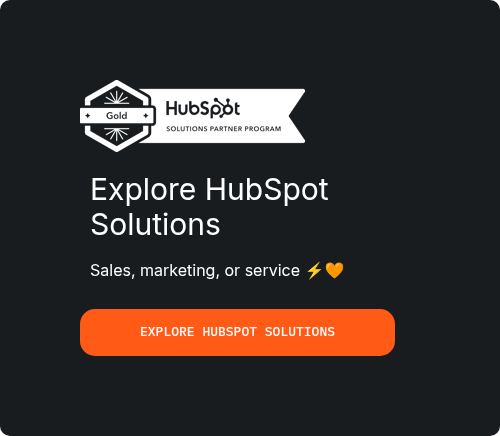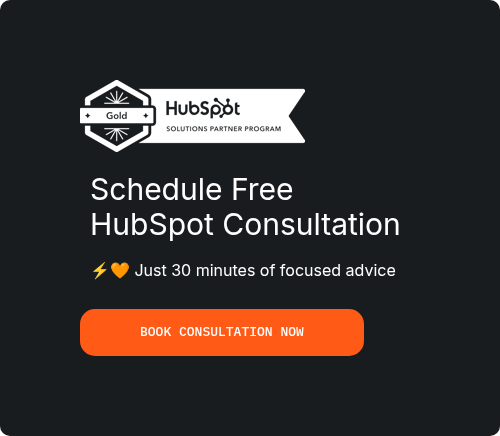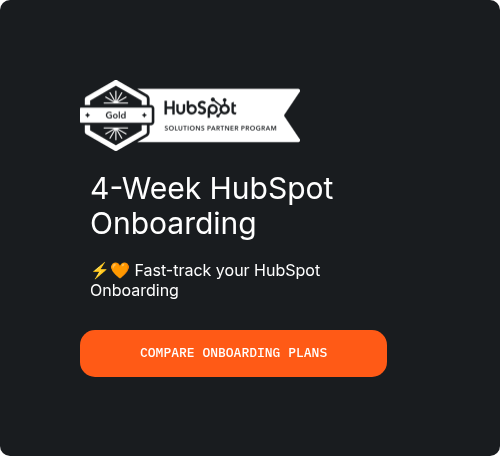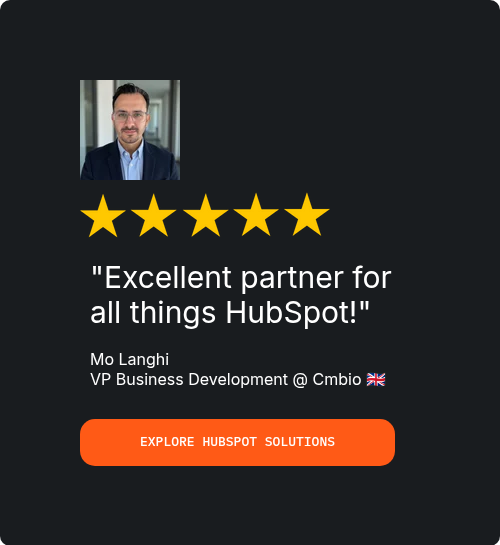
Why Startups Must Think in Systems, Not Features
HubSpot Marketing Hub isn’t just a toolbox—it’s a marketing operating system. For startups especially, this distinction matters. While most teams start by experimenting with one or two features—like email campaigns or landing pages—the true value lies in the synergy between its core components.
Here’s a quick breakdown:
- Lead Capture & Management ensures you're collecting the right contacts, not just random form fills.
- Email Marketing provides direct, automated nurturing to move leads down the funnel.
- Marketing Automation scales your outreach without scaling headcount.
- CMS connects your content with your CRM—so web visitors aren’t just clicks, but data-rich profiles.
- Social Media Management centralizes scheduling and performance across platforms.
- Analytics & Reporting closes the loop so you can attribute, learn, and iterate with precision.
Before onboarding, your team must stop thinking in silos and start thinking in systems. When these tools are connected intentionally, that’s when HubSpot becomes a growth machine—not a chaotic mess of dashboards.
Step 1: Preparing for Onboarding
Before jumping into workflows and integrations, successful HubSpot Marketing Hub onboarding begins with clarity—not configuration. The most costly mistake startups make is diving into setup without a clearly defined strategy or measurable goals.
HubSpot isn’t a plug-and-play tool; it’s a framework that must be molded around your unique growth model.
Start by identifying what success looks like for your team. Is your primary goal to generate qualified leads, improve email engagement, reduce manual tasks, or track marketing ROI more accurately?
Your answers here will determine how the system should be architected.
Once your objectives are clear, outline your marketing strategy—mapping out the buyer’s journey, defining lifecycle stages, and segmenting your ICPs (Ideal Customer Profiles).
From there, you can begin aligning HubSpot’s modules—like lead scoring, automation triggers, and campaign tracking—to support those goals.
Proper onboarding is not about implementing features—it’s about enabling outcomes.
When you define your strategy upfront, the implementation becomes a reflection of business intent, not just technical execution. That alignment is what turns HubSpot from a toolkit into a growth engine.
Step 2: Your HubSpot Control Center – Getting the Essentials in Place
Think of your HubSpot Marketing Hub account as the control center of your entire marketing operation. Before you run campaigns or build workflows, you need to configure the engine room.
Begin with user setup—define roles, permissions, and invite team members who’ll own different parts of the marketing stack. Then, move into branding basics: set your logo, colors, and email footers so everything you create aligns with your identity.
Next, ensure your tracking infrastructure is in place. Install the HubSpot tracking code on your website, connect your ad accounts, and verify your email sending domain. This will allow full funnel visibility and ensure data syncs cleanly from the start.
This setup isn’t just administrative—it’s the key to ensuring your future marketing is measurable, cohesive, and efficient.
Step 3: Evaluate Your Onboarding Options — Onboarding with HubSpot vs A HubSpot Agency Partner

When it comes to implementing HubSpot Marketing Hub, startups are typically faced with two paths: go through HubSpot’s standard onboarding service or work with a certified HubSpot Solutions Partner.
HubSpot’s own onboarding is solid for getting the basics in place—account setup, core tools, and access to self-guided resources. However, it’s often templated, time-boxed, and not tailored to the nuanced needs of fast-moving startups. You’ll likely find yourself juggling strategy, technical setup, and execution internally—without the bandwidth or expertise to do it all right the first time.
In contrast, partnering with a certified HubSpot agency like Pixcell.io gives you access to a team that understands both the platform and how to map it to your unique go-to-market strategy.
From building custom lead scoring models to implementing lifecycle automation, we ensure your onboarding goes beyond the checklist—delivering a scalable marketing engine aligned with your growth goals.
With HubSpot, you’ll learn how the tool works. With Pixcell.io, you’ll make the tool work for you.
Step 4: Set a Realistic Timeline for Your HubSpot Marketing Hub Onboarding
One of the most common mistakes startups make during onboarding is underestimating how much time the process actually requires.
While HubSpot is designed for ease of use, building a tailored, high-performing setup takes planning, coordination, and execution across multiple areas of your marketing stack.
Here’s a realistic onboarding timeline to guide your expectations:
- Initial Setup (1–2 weeks): This includes setting up your account, branding, users, custom properties, and connecting core tools like your CRM, email domain, and tracking scripts.
- Strategic Implementation (4–6 weeks): This is where the heavy lifting happens—mapping out your marketing funnels, building lead capture flows, automating emails, setting lifecycle stages, integrating external platforms, and configuring reporting dashboards.
- Ongoing Execution (10–20 man-hours per month): Even after launch, you’ll need consistent effort for campaign builds, performance reviews, optimization, and maintaining data hygiene. This effort is often split between marketing, sales ops, and a technical resource (internal or agency).
Setting a clear timeline early ensures your team (or agency partner like Pixcell.io) can align deliverables, track progress, and avoid rushed, misaligned execution. HubSpot can deliver immense ROI—but only when given the right runway to get off the ground.
In fact, a strong HubSpot Marketing Hub ROI typically starts at a 5:1 ratio, meaning for every $1 spent, you should aim to generate at least $5 in return. According to industry benchmarks, a 10:1 ROI is considered exceptional, while anything below 2:1 is often seen as barely breaking even.
This is why defining both your timeline and investment early on isn’t just good planning—it’s what separates high-performing teams from those left wondering why their automation platform isn’t delivering results.
Step 5: Establish Your Budget
HubSpot is a powerful tool—but like any investment, its ROI depends on how well you align features, strategy, and resources. That’s why establishing a realistic budget upfront is critical—not just for licensing fees, but also for implementation, enablement, and ongoing management.
Let’s break it down:
- Marketing Hub Starter: Perfect for early-stage startups, this plan is free or low-cost, giving you access to basic forms, emails, and tracking tools. Great for testing waters, but limited in automation and reporting.
- Marketing Hub Professional: Starting at $800/month, this is where serious growth begins. You unlock workflow automation, custom reports, dynamic lists, and more—ideal for scaling companies ready to build a structured lead engine.
- Marketing Hub Enterprise: Starting at $5,000/month, this tier is built for scale. You get multi-touch attribution, advanced segmentation, permission controls, and custom objects—features that enterprise teams need to operate at full complexity.
💡 Pro Tip: Use HubSpot’s Pricing Calculator or speak directly with a rep to get accurate cost estimates. Also consider bundling with other hubs (Sales, Service, CMS, or Operations) to unlock deeper platform efficiencies—and potential pricing discounts.
Pixcell.io often helps clients navigate these decisions—whether it’s choosing the right plan, leveraging startup discounts, or structuring an onboarding plan that maximizes ROI. The goal isn’t to spend more—it’s to spend smarter, and set up a foundation that scales with your growth.
Step 6: Reporting and Analytics Configuration
You can’t improve what you don’t measure—and with HubSpot Marketing Hub, reporting isn’t just a nice-to-have. It’s your real-time feedback loop for everything from email performance to campaign ROI.
During onboarding, one of the most overlooked (yet critical) steps is properly setting up reporting and analytics tailored to your goals. HubSpot offers built-in dashboards, but to unlock real value, you’ll want to configure custom reports aligned with your funnel stages, lifecycle metrics, and lead sources.
Here’s where to focus:
- Set Baselines: Define your key metrics early—visits, leads, MQLs, SQLs, conversion rates, CAC, etc.—so you can benchmark performance over time.
- Build Role-Based Dashboards: Sales and marketing teams need different insights. Create separate views for each team, with data visualized around their objectives.
- Attribution Reporting: Configure multi-touch attribution to track which campaigns, content, or channels actually contribute to closed deals—not just clicks.
- Campaign-Level Insights: Group assets into campaigns so you can monitor how emails, ads, landing pages, and forms perform as a cohesive effort.
Proper configuration here ensures you're not just collecting data—you’re using it to make better decisions, faster.
Advantages HubSpot Marketing Hub Onboarding with a HubSpot Agency Partner
|
Criteria |
With a HubSpot Agency Partner (e.g., Pixcell.io) |
DIY Onboarding (In-House) |
|
Speed to Launch |
Accelerated setup with proven frameworks and fewer mistakes |
Slower implementation; steep learning curve |
|
Expertise & Best Practices |
Access to HubSpot-certified specialists with experience across industries |
Reliant on internal team’s learning and trial/error |
|
Custom Strategy Alignment |
Onboarding tailored to your ICP, lifecycle stages, and funnel strategy |
Risk of generic setups or misalignment with actual business needs |
|
Tech Stack & Integration Support |
Expert help with 3rd-party integrations, API setup, and syncing tools properly |
Requires in-house technical skill or external dev support |
|
Scalability & Future-Proofing |
Architecture built with future campaigns, growth, and scaling in mind |
Often reactive, requiring rework as complexity grows |
|
Ongoing Support & Training |
Dedicated support, enablement sessions, and guided handover |
Self-serve resources and community forums |
|
ROI Realization Timeline |
Faster time-to-value; avoid missteps that slow down growth |
Slower ROI; risk of underutilizing features |
|
Cost |
Higher upfront investment, lower long-term inefficiency costs |
Lower short-term spend, but higher long-term risk & rework cost |
How to Choose the Right Agency for HubSpot Onboarding
1. Do You Understand Our Business Model and Growth Goals?
HubSpot is flexible—but it needs to be molded to your business. A great agency won’t just know HubSpot inside-out; they’ll ask about your ICPs, funnel stages, revenue goals, and how marketing connects with sales. Look for partners who prioritize strategic alignment, not just technical execution.
2. Can You Show Examples of Startups You've Onboarded Successfully?
Past performance is a great indicator of expertise. Ask to see real onboarding case studies, especially for early- to mid-stage startups in your industry or go-to-market model (e.g., SaaS, DTC, B2B services). Bonus points if they’ve helped teams with lean headcount or limited in-house ops support.
3. How Do You Approach Customization vs. Standard Setup?
Every startup is different—your automation, lead scoring, and reporting setup shouldn’t look like a carbon copy of someone else’s. Ask how the agency balances speed with flexibility and whether they provide a tailored onboarding plan versus relying on out-of-the-box templates.
4. What’s Included in Your Onboarding Package—and What Isn’t?
Clarity is everything. Get specifics on what deliverables are included: strategy workshops, CRM setup, workflow builds, lifecycle mapping, training, reporting, and integrations. Understand what’s covered upfront and what’s considered post-onboarding or part of a retainer.
5. How Do You Support Us After Onboarding is Complete?
A smooth onboarding is just the beginning. Ask about post-launch support, team enablement, and how knowledge transfer is handled. Will you get documentation, recorded trainings, or ongoing optimization? The right partner won’t vanish after setup—they’ll ensure you’re fully equipped to scale.
Pixcell.io – Your Experienced HubSpot Agency Gold Partner

At Pixcell.io, we don’t just implement HubSpot—we help startups build growth engines around it.
As a certified HubSpot Gold Solutions Partner, we’ve supported fast-scaling SaaS, services, and B2B startups in transforming HubSpot Marketing Hub from a tool into a fully integrated revenue system. From onboarding to automation, from CRM alignment to multi-channel analytics—our process is rooted in clarity, customization, and outcomes.
Here’s what sets us apart:
- Startup-First Approach – We understand lean teams, rapid pivots, and the urgency to prove ROI fast.
- Full-Funnel Implementation – We align HubSpot’s Marketing Hub with your sales pipeline, lifecycle stages, and GTM strategy.
- Data-Driven Setup – Every workflow, lead score, and dashboard is designed to surface insight—not noise.
- Hands-On Partnership – We don't disappear after onboarding. We train, optimize, and support your team through every stage of growth.
Whether you're pre-launch or post-Series A, Pixcell.io helps you make HubSpot work for your exact business model—not the other way around.
Let’s get your marketing engine firing on all cylinders.






